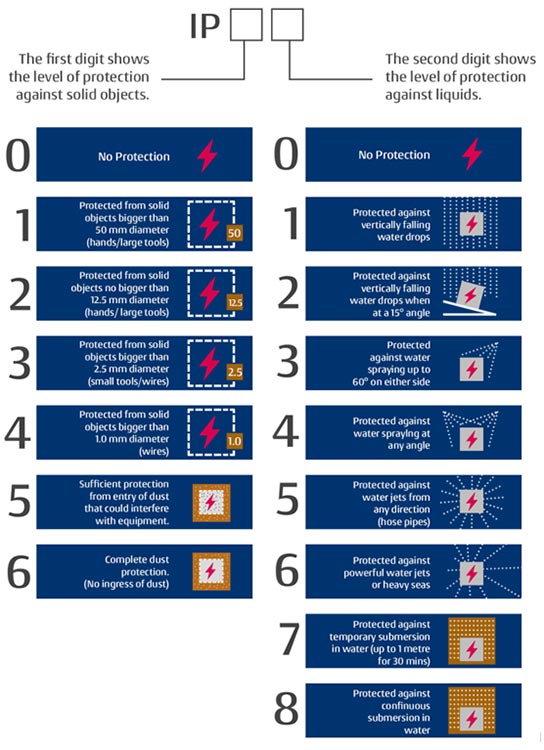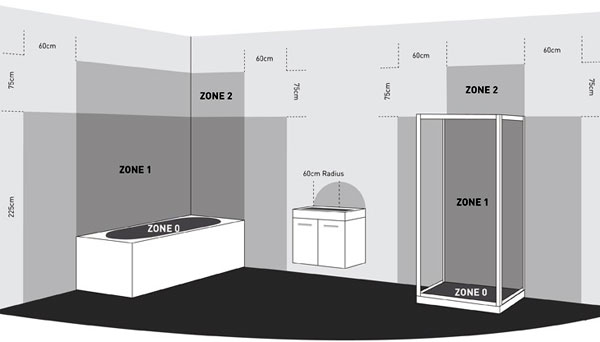Bathroom Light Zones and IP Ratings Explained
Consideration of bathroom lighting extends beyond pure aesthetics due to the presence of water and steam within the room. Bathrooms and shower rooms are areas of high risk due to the very low resistance of the human body when wet or immersed in water. Rigorous precautions must be taken when choosing and installing your bathroom lighting. We strongly recommend that you contact an electrician registered with one of the governments approved schemes to carry out any electrical work that you need within the bathroom. Find a local qualified electrician by visiting https://www.competentperson.co.uk/.
Lighting in the bathroom is important. Regulations are very strict as to which lights you are able to use in a bathroom and to complicate matters, bathrooms have different zones, which determine what type of light you may use within that zone. Light fittings that are used in a bathroom are IP rated.
Whether you have a bathroom, a shower room or a wet room, the area of the room is divided into zones.
Bathroom Zones
Zone 0: This zone relates to the physical space within the tub or in simple terms, the area in which you would sit in if taking a bath. For showers, Zone 0 alludes to the foot basin space. Any lighting within this area must be low voltage, to a maximum of 12v and any transformer or LED driver must be located outside of the bathroom. Lights must be a minimum of IP67 which means they are protected against the effects of immersion.
Zone 1: This is the area above the bath or shower to a height of 2.25m from the floor. Light fittings within this area must reach a minimum of IP44, however, shower lights are generally designed to IP65 and are perfect for use in Zone 1 installations. There is no requirement for lights to be low voltage within this zone.
Zone 2: Zone 2 is the area immediately adjacent to the bathtub or shower foot basin and also from the taps of any hand basin with an additional 0.6m added for safety purposes. Again, any equipment should be subjected to a minimum IP44 rating. There is no Zone 2 in a wet room.
Outside of zones: The rest of your bathroom falls into this area and doesn’t require an IP rating for any of the lights used. It’s often recommended however that any downlights, wall lights or ceiling lights you might choose have a rating of at least IP44. This helps ensure that the lights are well protected from unintentional splashing or steam, as steam will make its way out of the shower area. Having IP44 rated lights will ensure that they are protected from corrosion and prolong their life.
What does IP rating mean for bathroom lights?
Ingress Protection rating: Ingress means entering, in the case of bathroom lights it means, water or steam entering a light fitting – Ingress protection means the amount it is protected. There are various Ingress Protection ratings =IP ratings. The higher the IP rate is, the more protected the light is.
The rating refers to the light fittings ability to prevent solids or liquids penetrating the device’s enclosure.
IP rating: An IP rating will have 2 or 3 numbers after it, for example IP 68. The first number corresponds to solid material entering the light fitting. E.g. Dust, tools, fingers etc. The second number would correspond to water or steam entering the light fitting.
Every light fitting has an IP rating. Bathroom lights must have higher IP ratings than lights you would use in the lounge, dining room or bedrooms etc.

Whilst it is important to select the style of fitting to suit your decor, safety is the most important factor when choosing a light for your bathroom. The guidelines for bathroom lights, above will help you decide which zone sector the requirements are for the positioning of light fittings in the bathroom.
The light in a bathroom needs to be as bright and as evenly spread as possible without any glare to the eye. The most important area to concentrate on usually, is around the wash basin area for make – up application and shaving etc. It is important to remember that a central bathroom ceiling light will create shadows whilst facing into a mirror at the basin area. The use of mirror lights on or over the mirror will help combat this.

